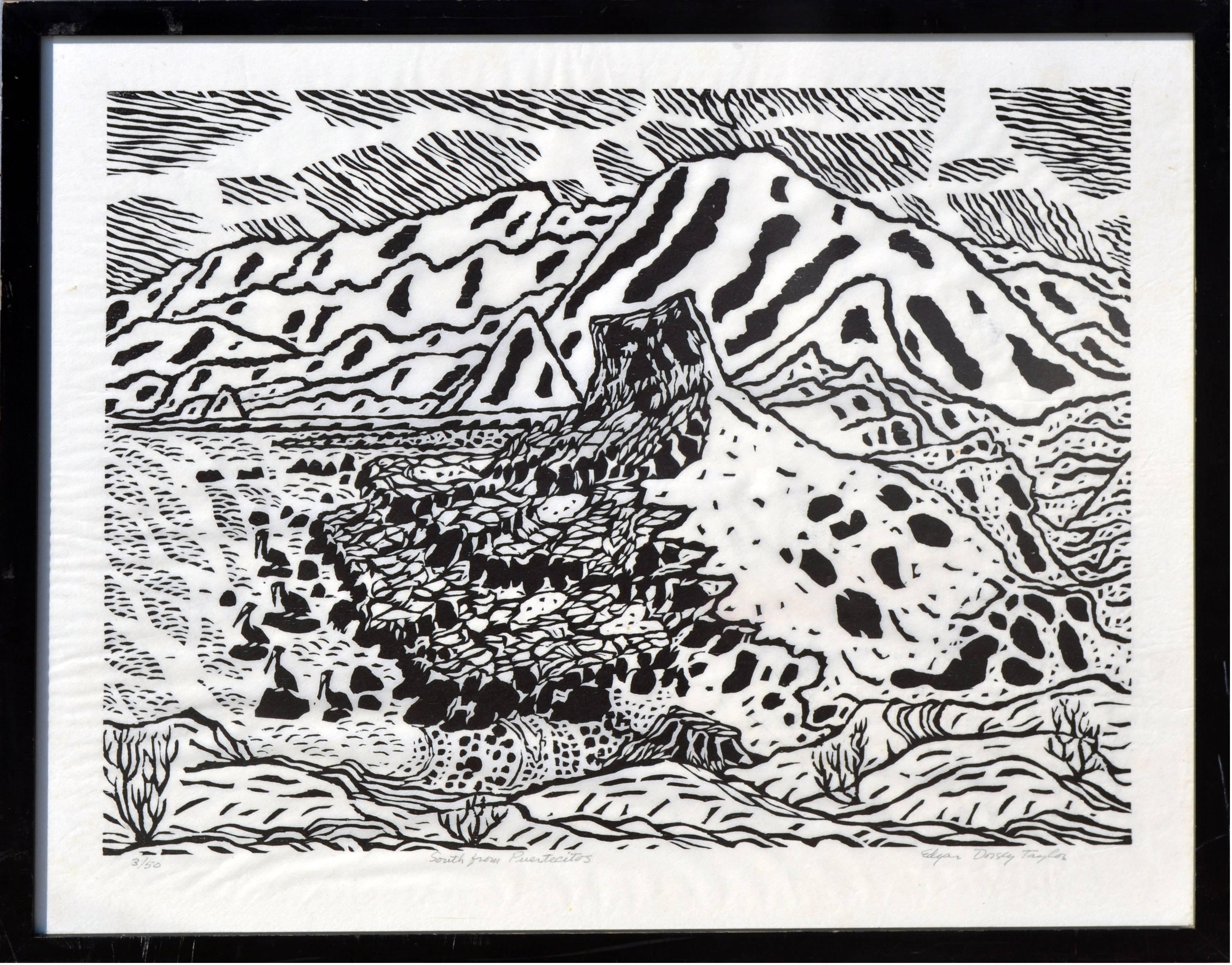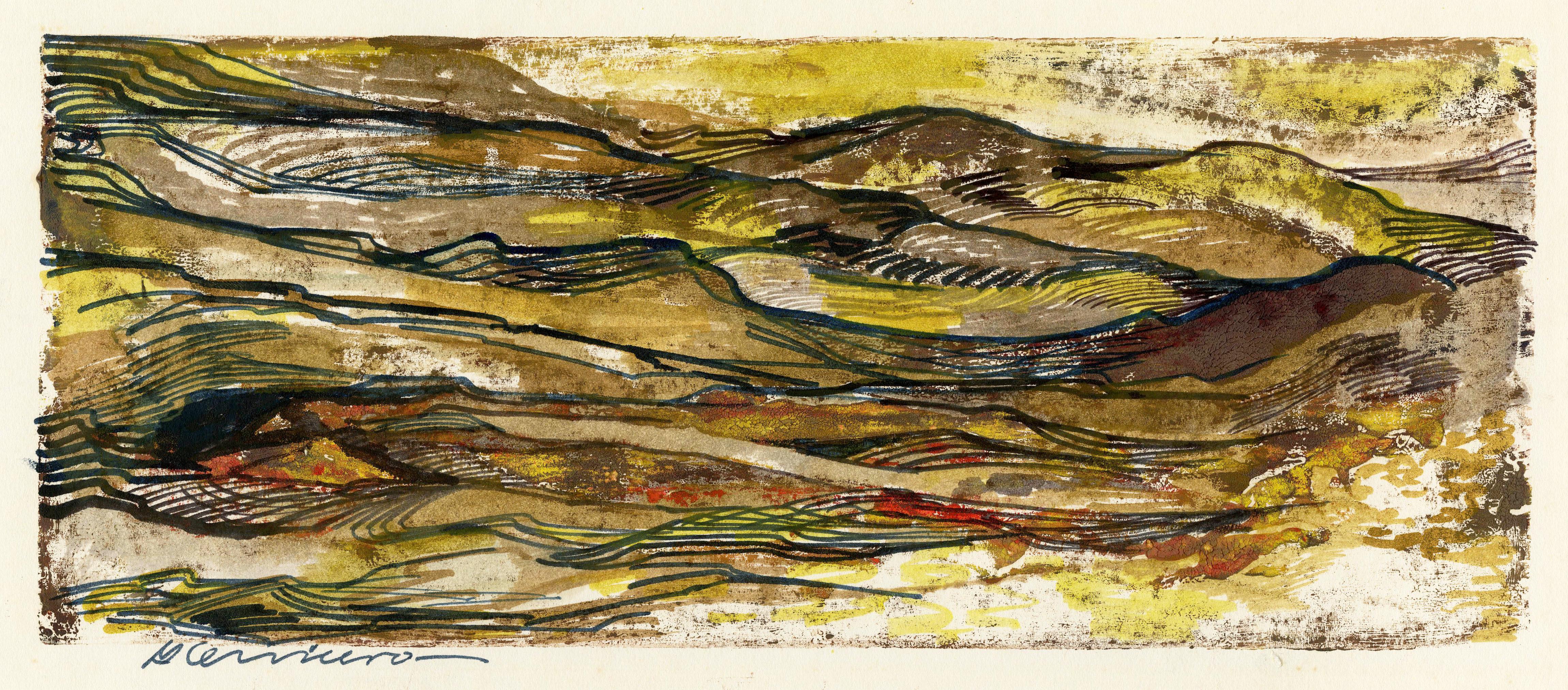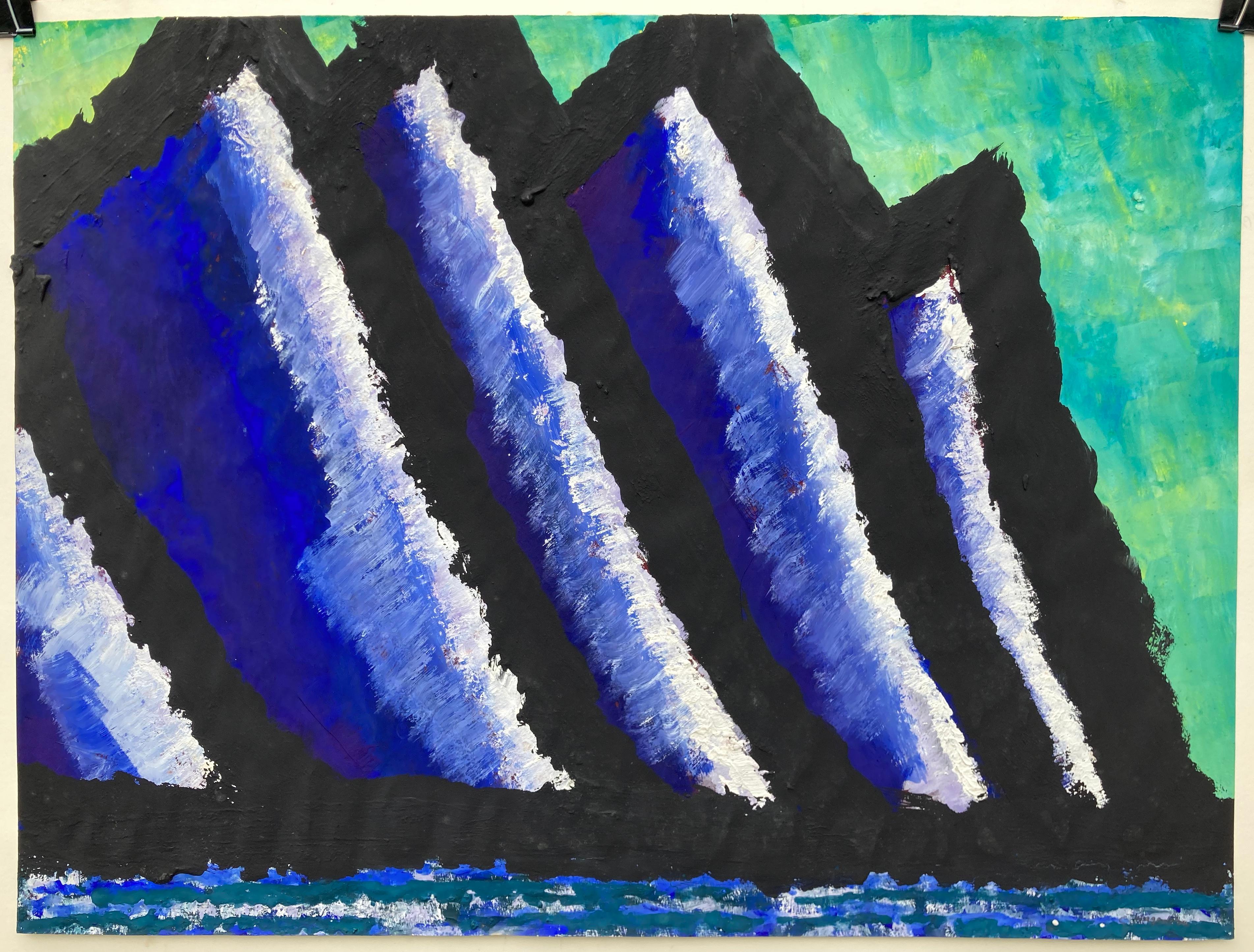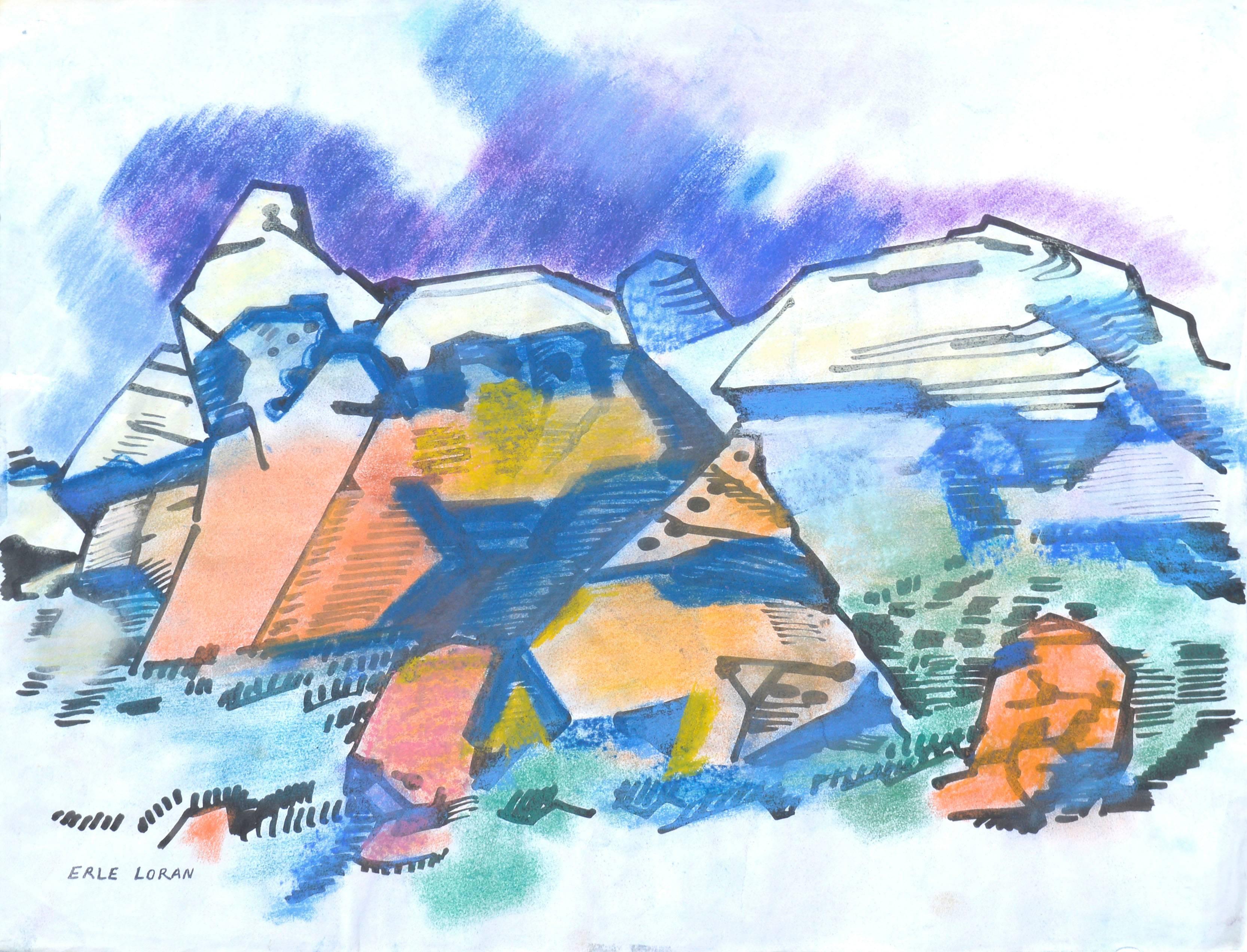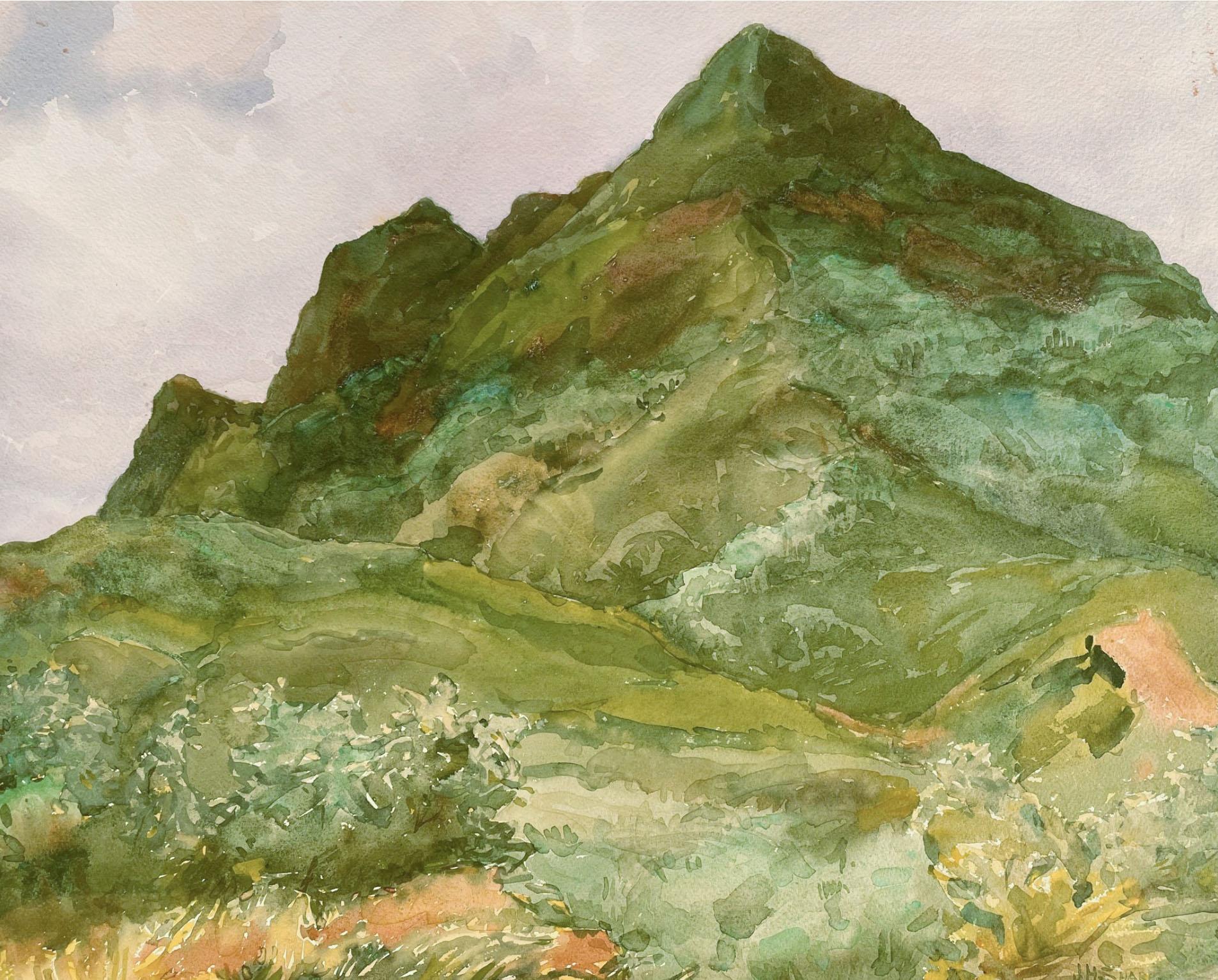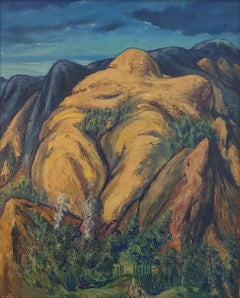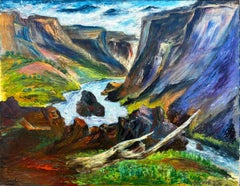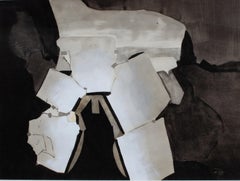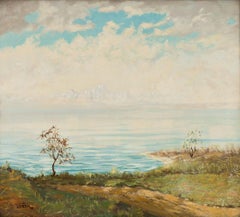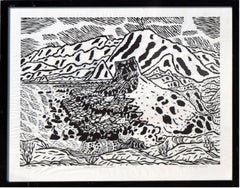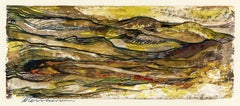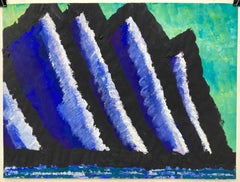Items Similar to "Andes Mountains Peru South America, " Joseph Yoakum, Black Folk Art Landscape
Want more images or videos?
Request additional images or videos from the seller
1 of 8
Joseph Yoakum"Andes Mountains Peru South America, " Joseph Yoakum, Black Folk Art Landscapecirca 1960s
circa 1960s
$17,600
$22,00020% Off
£13,361.62
£16,702.0220% Off
€15,282.84
€19,103.5520% Off
CA$24,589.75
CA$30,737.1920% Off
A$27,349.17
A$34,186.4620% Off
CHF 14,280.89
CHF 17,851.1120% Off
MX$332,810.33
MX$416,012.9220% Off
NOK 182,388.73
NOK 227,985.9120% Off
SEK 171,048.45
SEK 213,810.5620% Off
DKK 114,061.71
DKK 142,577.1420% Off
Shipping
Retrieving quote...The 1stDibs Promise:
Authenticity Guarantee,
Money-Back Guarantee,
24-Hour Cancellation
About the Item
Joseph Yoakum
Andes Mountains Peru So America, circa 1960s
Colored pencil and ballpoint pen on paper
7 1/4 x 10 1/2 inches
Provenance:
Karen Lennox Gallery, Chicago
Private Collection, South Dakota
Yoakum began drawing in the early 1960s. Most of his work consists of radiantly colored landscapes with mountains, water, trees, and winding roads in abstract and complex configurations. his period of greatest activity — 1965 to 1970 — when he usually made one drawing a day.
Yoakum maintained he had seen all the places represented in his drawings, a statement that may not be true in some instances. He traveled a great deal, beginning in his early teens when he ran away from home and became a circus handyman. Yoakum’s drawings can be considered memory images growing out of either actual or imagined experiences. All of his drawings have titles that grew longer and more specific over the years. He dated his works with a rubber stamp — an oddly impersonal, labor-saving device.
Although Joseph Yoakum gave vastly different accounts of his background, he was, throughout his life, classified as an African American. Sometimes Yoakum claimed that he was a full-blooded “Nava-joe” Indian, one of twelve or thirteen children born to a farmer on an Indian reservation in Window Rock, Arizona. At other times he insisted that he was of African-American descent. He described his mother as a strong woman who was a doctor and knowledgeable in the use of herbal medicines. Yoakum’s family moved to Kansas City, Missouri, during his early childhood. His father was employed briefly in the railroad yards prior to settling permanently on a farm in nearby Walnut Grove in southwest Missouri. Although Yoakum said that his formal schooling consisted of only three or four months, the character of the notations on his drawings suggests greater exposure to formal training.
The early years of Yoakum’s life were apparently nomadic. He claimed to have run away from home during his early teens to join a circus. He also claimed to have worked with Buffalo Bill before 1903, when he became the personal valet of John Ringling of the Ringling Brothers Circus. Between 1905 and 1910, Yoakum may have visited Europe, Russia, Mexico, the Middle East, China, Siberia, Canada, Central America, and South America. His first marriage occurred around 1910 and produced five children. He married again in 1929.
Yoakum served in the Unites States Army during World War I and was stationed at one time in France. The specific location and nature of his activities after his military discharge until his artistic career began in the early 1960s are uncertain. Yoakum said that he worked at a variety of jobs throughout the United States. In the early 1940s, he and his wife operated an ice cream parlor on Chicago’s South Side. By the late 1950s, however, Yoakum was widowed, retired, and living in a housing project for the elderly in Chicago. In 1966, Yoakum moved from the project to a storefront on the South Side. He lived there until he was hospitalized and placed in a nursing home in 1971; he died there the following year.
According to Yoakum, he was motivated to draw as the result of a dream around 1962. He described his process of working as a “spiritual enfoldment,” meaning that his imagery was revealed as he worked. Yoakum’s earliest drawings were done on small pieces of white or Manila paper with pen or pencil and little or no color. He graduated to larger pieces of paper and applied more color to his drawings as he drew with greater frequency.
Although Yoakum enjoyed doing celebrity-oriented portraits, the majority of his drawings are landscapes. In his hundreds of variations, real or imagined, mountains and water are the major themes. Between 1965 and 1970, Yoakum drew constantly and sometimes completed several pictures a day, often similar in theme, yet distinctly different in design. He kept an assortment of travel books, an atlas, and the Encyclopedia Britannica and took great pains to include inscriptions that name geographical details ranging from valleys to continents. Nonetheless, the scenes in Yoakum’s landscapes are generally not identifiable. Yoakum usually signed and dated his landscapes in the upper left corner. Occasionally he used a rubber stamp to indicate the date adding what he called a “touch of class.” Yoakum’s world was intensely private. His religious beliefs were rooted in the view that God and nature were the same thing. He expressed this belief in hundreds of drawings that are delicate, sensitive, and poetic in contrast to the bold, if not brash, character of most contemporary folk art.
- Creator:Joseph Yoakum (1890 - 1972, American)
- Creation Year:circa 1960s
- Dimensions:Height: 13.5 in (34.29 cm)Width: 17 in (43.18 cm)
- Medium:
- Movement & Style:
- Period:
- Condition:
- Gallery Location:New York, NY
- Reference Number:1stDibs: LU1841211574642
About the Seller
5.0
Platinum Seller
Premium sellers with a 4.7+ rating and 24-hour response times
Established in 2022
1stDibs seller since 2022
114 sales on 1stDibs
Typical response time: <1 hour
- ShippingRetrieving quote...Shipping from: New York, NY
- Return Policy
Authenticity Guarantee
In the unlikely event there’s an issue with an item’s authenticity, contact us within 1 year for a full refund. DetailsMoney-Back Guarantee
If your item is not as described, is damaged in transit, or does not arrive, contact us within 7 days for a full refund. Details24-Hour Cancellation
You have a 24-hour grace period in which to reconsider your purchase, with no questions asked.Vetted Professional Sellers
Our world-class sellers must adhere to strict standards for service and quality, maintaining the integrity of our listings.Price-Match Guarantee
If you find that a seller listed the same item for a lower price elsewhere, we’ll match it.Trusted Global Delivery
Our best-in-class carrier network provides specialized shipping options worldwide, including custom delivery.More From This Seller
View All"Mexican Mountains, " Hendrik Glintenkamp, Modernist Landscape
By Hendrik Glintenkamp
Located in New York, NY
Hendrik (Henry) J Glintenkamp (1887 - 1946)
Mexican Mountains, 1940
Oil on canvas
32 x 26 inches
Signed lower left; signed and dated on the reverse
T...
Category
1940s American Modern Landscape Paintings
Materials
Canvas, Oil
$7,800 Sale Price
20% Off
"Cumbres Pass, Colorado" Chuzo Tamotzu, 1956 Intense Color, Modernist Landscape
Located in New York, NY
Chuzo Tamotzu
Cumbres Pass, Colorado, 1956
Signed and dated lower left; titled on artist label on the reverse
Oil on Masonite
36 x 48 inches
Tamotzu was born in Kagoshima Prefectur...
Category
1950s Modern Figurative Paintings
Materials
Masonite, Oil
"Cronus View from the Cave" David Hare, Abstract Surrealist Composition
By David Hare
Located in New York, NY
David Hare
Cronus View from the Cave, 1971
Graphite, Ink wash, Paper Collage on Paper on Board
25 x 33 inches
“Freedom is what we want,” David Hare boldly stated in 1965, but then he added the caveat, “and what we are most afraid of.” No one could accuse David Hare of possessing such fear. Blithely unconcerned with the critics’ judgments, Hare flitted through most of the major art developments of the mid-twentieth century in the United States. He changed mediums several times; just when his fame as a sculptor had reached its apogee about 1960, he switched over to painting. Yet he remained attached to surrealism long after it had fallen out of official favor. “I can’t change what I do in order to fit what would make me popular,” he said. “Not because of moral reasons, but just because I can’t do it; I’m not interested in it.”
Hare was born in New York City in 1917; his family was both wealthy and familiar with the world of modern art. Meredith (1870-1932), his father, was a prominent corporate attorney. His mother, Elizabeth Sage Goodwin (1878-1948) was an art collector, a financial backer of the 1913 Armory Show, and a friend of artists such as Constantin Brancusi, Walt Kuhn, and Marcel Duchamp.
In the 1920s, the entire family moved to Santa Fe, New Mexico and later to Colorado Springs, in the hope that the change in altitude and climate would help to heal Meredith’s tuberculosis. In Colorado Springs, Elizabeth founded the Fountain Valley School where David attended high school after his father died in 1932. In the western United States, Hare developed a fascination for kachina dolls and other aspects of Native American culture that would become a recurring source of inspiration in his career.
After high school, Hare briefly attended Bard College (1936-37) in Annandale-on-Hudson. At a loss as to what to do next, he parlayed his mother’s contacts into opening a commercial photography studio and began dabbling in color photography, still a rarity at the time [Kodachrome was introduced in 1935]. At age 22, Hare had his first solo exhibition at Walker Gallery in New York City; his 30 color photographs included one of President Franklin Roosevelt.
As a photographer, Hare experimented with an automatist technique called “heatage” (or “melted negatives”) in which he heated the negative in order to distort the image. Hare described them as “antagonisms of matter.” The final products were usually abstractions tending towards surrealism and similar to processes used by Man Ray, Raoul Ubac, and Wolfgang Paalen.
In 1940, Hare moved to Roxbury, CT, where he fraternized with neighboring artists such as Alexander Calder and Arshile Gorky, as well as Yves Tanguy who was married to Hare’s cousin Kay Sage, and the art dealer Julian Levy. The same year, Hare received a commission from the American Museum of Natural History to document the Pueblo Indians. He traveled to Santa Fe and, for several months, he took portrait photographs of members of the Hopi, Navajo, and Zuni tribes that were published in book form in 1941.
World War II turned Hare’s life upside down. He became a conduit in the exchange of artistic and intellectual ideas between U.S. artists and the surrealist émigrés fleeing Europe. In 1942, Hare befriended Andre Breton, the principal theorist of surrealism. When Breton wanted to publish a magazine to promote the movement in the United States, he could not serve as an editor because he was a foreign national. Instead, Breton selected Hare to edit the journal, entitled VVV [shorth for “Victory, Victory, Victory”], which ran for four issues (the second and third issues were printed as a single volume) from June 1942 to February 1944. Each edition of VVV focused on “poetry, plastic arts, anthropology, sociology, (and) psychology,” and was extensively illustrated by surrealist artists including Giorgio de Chirico, Roberto Matta, and Yves Tanguy; Max Ernst and Marcel Duchamp served as editorial advisors.
At the suggestion of Jacqueline Lamba...
Category
1970s Abstract Abstract Paintings
Materials
Paper, Ink, Graphite
"Western Lake Landscape, " John Fery, Hudson River School View
By John Fery
Located in New York, NY
John Fery (1859 - 1934)
Western Lake Landscape, circa 1920
Oil on canvas
21 x 23 1/4 inches
Signed lower left
Provenance:
Private Collection, New York
Born in Austria, John Fery earned a strong reputation for dramatic paintings of western mountain landscape in the United States. Glacier National Park in northwest Montana was a popular subject for him.
He was raised in a prominent, wealthy family that lived on an estate about nineteen miles northeast of Salzburg. His mother was Hungarian, and his father was born in Bohemia. S ome sources have written that he studied art in Dusseldorf, Germany with Peter Jansen, and also in Munich, Venice and Karlsruhe. But his "name does not appear in the records of the major art schools in any of these places, nor is there any record of his name at either the Vienna or Budapest academies." (Merrill 26) It is possible, however, that he received private instruction, and because of the sophistication of his painting, sources think it unlikely that he was self taught.
An early interest in wilderness scenery led him to painting American landscapes and hunting scenes. In the mid 1880s, he came to America and lived in the German community in Milwaukee, and then in 1886, brought his family to the United States. His wife, Mary Rose Kraemer (1862-1940), was born in Switzerland, and they had one child born near Munich and two others born in the United States. From 1886 to 1888, they lived in New York, and by 1890, Fery had made his first trip West.
He visited Yellowstone Park in 1891, and indicated in his writings that he had been there even earlier. From 1892 to 1893, he led European nobility on hunting expeditions to the American Northwest, made possible by the completion of the Northern Pacific Railroad...
Category
1920s Hudson River School Landscape Paintings
Materials
Canvas, Oil
$9,600 Sale Price
20% Off
"Desert" Georgina Klitgaard, Modernist Desert Landscape With Waning Moon
By Georgina Klitgaard
Located in New York, NY
Georgina Klitgaard
Desert
Signed lower right
Oil on canvas
18 x 30 inches
Georgina Klitgaard’s art has sometimes gotten lost in the critical propensity to assign artists to members...
Category
1940s Modern Landscape Paintings
Materials
Oil
"Abolicion de la Muerte" Fernando de Szyszlo, Grey Abstract Surrealist Painting
By Fernando de Szyszlo
Located in New York, NY
Fernando de Szyszlo
Abolicion de la Muerte, 1987
Titled dated verso: "Abolicion de la Muerte"
NY/87
Signed lower bottom edge center "Szyszlo"
Oil on canvas
56 1/2 x 37 1/2 inches
Fernando de Szyszlo was a Peruvian painter...
Category
1980s Abstract Abstract Paintings
Materials
Canvas, Oil
You May Also Like
Mid Century Abstracted Landscape -- South from Puertecitos
By Edgar Dorsey Taylor
Located in Soquel, CA
A striking woodcut landscape print from Edgar Dorsey Taylor's series of prints depicting his adventures in Baja California in 1963 (American, 1904-1978). Also, the book titled "Baja ...
Category
1960s Abstract Impressionist Landscape Prints
Materials
Archival Paper, Woodcut
Mountainous Landscape, Mexico
Located in Fairlawn, OH
Mountainous Landscape, Mexico
Monotype in colors on heavy paper, c. 1960's
Signed in ink lower left "G Ceniceros"
Condition: Excellent
Image size: 6 x 14 1/2" (15.24 x 36.83cm)
Sheet size: 12 7/8 x 19 11/16 inches
Guillermo Ceniceros (born May 7, 1939) is a Mexican painter and muralist, best known for his mural work in Mexico City, as well as his figurative easel work. He began his mural painting career as an assistant to mural painters such as Federico Cantú, Luis Covarrubias and then David Alfaro Siqueiros who was a mentor and a key influence. Ceniceros is the most notable of Siqueiros' assistants. While he has experimented with abstract expression, his easel work mostly classifies as figurativism and is influenced by the geometrical construct of Mexican muralism. He has had over 300 individual and collective exhibitions in Mexico and the International stage. His work has been recognized by the Mexican Ministry of Culture and several of its institutions. He has painted over 20 large scale Mural Paintings with some of the most notable being the large scale work for the Legislative Palace of San Lazaro (Mexico's Legislative Building) as well as his murals in the Metro Subway System. He is a member of the Salón de la Plástica Mexicana. In 1995, the State of Durango, Ceniceros' native state, opened to the public the Guillermo Ceniceros Art Museum within the oversight of the Ministry of Culture. Ceniceros has been reviewed by notable critics such as Berta Taracena, Raquel Tibol, Alaide Foppa, Graciela Kartofel, José Angel Leyva and Eduardo Blackaller among others. There are several publications about his work including a vast review of his art life endeavors developed by the Ministries of Culture of Durango and Nuevo León. He is married to the artist Esther González and lives in his studio house in the Colonia Roma of Mexico City.
Life
Interview with the subject Ceniceros and Siqueiros
Ceniceros was born in a small village called El Salto, located in the municipality of Pueblo Nuevo in the Mexican state of Durango. His father was a woodworker who made toys and furniture in his workshop. His father's shop would become an influence in Ceniceros' life long interest in developing his own innovative working tools. When he was twelve the family moved to Monterrey to seek better economic opportunities. There he attended school and when he was fourteen he entered the Fabricación de Máquinas, S.A. (FAMA), a school/business, where he studied industrial drawing. He considers this early training important as it taught him the importance of geometry, use of space and materials. While at FAMA he met painters Gerardo Cantú and Ignacio Ortiz, and collaborated with them on sketches for publications of Alfonso Reyes, Pedro Garfias and other notable writers.
In 1955, he enrolled in the Taller de Artes Plásticas at the Universidad Autónoma de Nuevo León, graduating in 1958. At the Taller he met fellow Mexican artist Esther González, whom he married and with whom he has two children.
In 1962 he moved to Mexico City with the goal of working in the Taller of the Maestro David Alfaro Siqueiros. He became Siqueiros' first assistant working on his last murals while at the same time working at night on his easel painting work. Siqueiros supported Ceniceros decision to leave his Taller and supported him in his career until his death in 1974. By then Ceniceros was already a break thru artist having had several individual exhibitions including the prestigious Palacio De Bellas Artes as well as other recognitions. Thru the 70's and 80s Ceniceros continued his work with an emphasis on exhibits and exchanges abroad and traveling to Eastern Europe, Cuba, China, Chile, Ecuador, Italy and the United States. His Mexico City contemporaries and circle would include names that today have become reference such as Sebastian, José Luis Cuevas, Gilberto Aceves Navarro, Benjamin Dominguez, Gustavo Arias Murueta, Byron Galvez, Leonel Maciel among others. In the 70's his Row-House neighbors in the colonia Roma were Francisco Toledo and Alejandro Jodorowski.
His focus on mural painting is renewed in the mid 80's thru his large scale work in the Metro Subway System with him working on major commissions consistently and into the new century. While the Mexican school of Muralism had been challenged by the Ruptura members, the interest in Mural painting as a unique national form of expression continues.
He lives in Mexico City at a studio/home in the Colonia Roma. His home is a frequent gathering place for writers, poets, painters, singers, actors and journalists. He has a strong interest in Spanish language literature. Juan Rulfo...
Category
1960s Modern Landscape Drawings and Watercolors
Materials
Monotype
Cayembe (Contemporary Landscape Oil Painting of Volcano in the Ecuadorian Andes)
By Bill Sullivan
Located in Hudson, NY
36 x 72 inches with thin wood frame
$8,500
Modern, horizontal landscape oil painting of a large volcano in the Ecuadorian Andes. The oil painting is very colorful with highly sat...
Category
1980s Modern Landscape Paintings
Materials
Canvas, Oil
UNTITLED MOUNTAINS
By Edward Hagedorn
Located in Santa Monica, CA
EDWARD HAGEDORN (AMERICAN 1902 – 1982)
UNTITLED MOUNTAINS, ca 1935
Tempera, Unsigned. Image 18 x 24 inches. See also 1stdibs item LU411312750272 for another example form the follow...
Category
1930s Surrealist Landscape Drawings and Watercolors
Materials
Tempera
Price Upon Request
Wyoming Abstract #4 - Mid Century Abstract Landscape
By Erle Loran
Located in Soquel, CA
Stunning pastel on paper of Wyoming by Erle Loran (American, 1905-1999). Erle Loran was a modernist of urban and coastal views and geometric painting. Signed lower left." Unframed. Image, 14"H x 17"L. Condition: minor age toning to edges and pastel smudges.
Erle Loran was born in Minneapolis, Minnesota. He studied at the Minneapolis School of Art under the direction of Cameron Booth...
Category
1960s Abstract Impressionist Landscape Paintings
Materials
Pastel, Archival Paper, Permanent Marker
$1,516 Sale Price
20% Off
New Mexican Mountain Scene
By Joseph Henry Sharp
Located in New York, NY
New Mexico Mountain Scene by Joseph Henry Sharp (1859-1953)
Watercolor on paper
15 ¾ x 19 ½ inches unframed (40.005 x 49.53 cm)
23 x 26 ¾ inches framed...
Category
20th Century Post-Modern Landscape Drawings and Watercolors
Materials
Watercolor
Price Upon Request
More Ways To Browse
French Military Art
Russian Art Books
Colored Pencil Landscape
Doctor Vintage
Joseph And His Brothers
Peruvian Vintage
Indian Pencil
Southwest Indian Art
Dior So Real
Mexican Folk Art Painting
African American Folk Art Painting
Tree Of Life Folk Art
Vintage Circus Theme
Bill Drew
Orient Express
1929 Water Color Painting
Chinese Blood
Chinese Woman Portrait Painting
